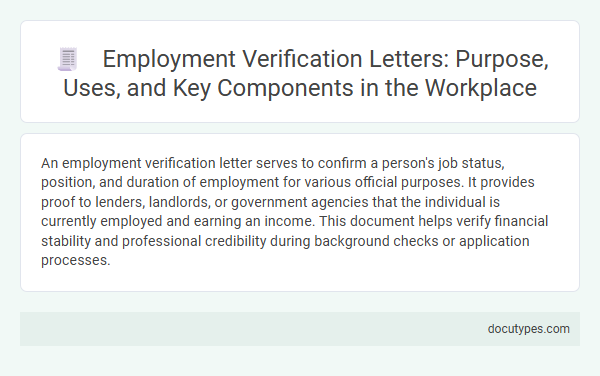An employment verification letter serves to confirm a person's job status, position, and duration of employment for various official purposes. It provides proof to lenders, landlords, or government agencies that the individual is currently employed and earning an income. This document helps verify financial stability and professional credibility during background checks or application processes.
Introduction to Employment Verification Letters
An employment verification letter serves as official confirmation of a person's job status, position, and duration of employment. This document is often requested by landlords, financial institutions, or prospective employers to validate employment details.
Your employment verification letter provides accurate information about your work history and current employment standing. It helps establish credibility and supports applications for loans, rentals, or new job opportunities.
Purpose of Employment Verification Letters
What is the purpose of an employment verification letter? An employment verification letter serves to confirm a person's job status, position, and length of employment. Employers, landlords, and financial institutions use this document to validate employment information for various official requirements.
Common Uses of Employment Verification Letters
An employment verification letter confirms an individual's current or past work status with a company. It serves as official proof of employment details requested by third parties.
- Loan Applications - Verifies income and job stability to support credit approval processes.
- Rental Agreements - Confirms employment status and income for landlords assessing tenant eligibility.
- Immigration Requests - Provides proof of employment required for visa or residency applications.
Employment verification letters help establish trust and authenticity between employees, employers, and external parties.
Key Components of an Employment Verification Letter
An employment verification letter confirms an individual's current or past job status for third parties. Its main purpose is to provide proof of employment details requested by banks, landlords, or other institutions.
The key components ensure the letter is informative and credible for Your verification needs.
- Employee Information - Includes the full name, job title, and employment dates to identify the individual accurately.
- Company Details - Provides the employer's name, address, and contact information to validate the source.
- Employment Status - States whether the employee is active, their work schedule, and possibly salary information if requested.
Who Can Request an Employment Verification Letter?
An employment verification letter confirms an individual's job status, position, and length of employment. Employers, landlords, financial institutions, and government agencies are the primary entities that can request this letter to verify your employment details. This document ensures credibility and supports applications for loans, rental agreements, or background checks.
Types of Employment Verification Letters
An employment verification letter serves to confirm a person's job status, income, and other relevant details for various official purposes. Understanding the types of employment verification letters helps you identify which one suits your needs.
- Standard Employment Verification Letter - Confirms your current job title, duration, and salary as requested by third parties.
- Income Verification Letter - Provides detailed proof of your earnings, often required for loan or rental applications.
- Employment Reference Letter - Highlights your job performance and skills to support job applications or promotions.
Legal and Privacy Considerations
An employment verification letter serves to confirm your job status, position, and salary details for third parties. It is essential in legal contexts to provide accurate information while respecting privacy laws.
Employers must ensure the letter complies with data protection regulations, disclosing only necessary information. Unauthorized release of personal employment details can lead to legal liabilities. Maintaining confidentiality supports both legal adherence and employee trust.
Best Practices for Writing Employment Verification Letters
An employment verification letter confirms an individual's job status, position, and duration of employment for third parties such as landlords, lenders, or government agencies. Accuracy and clarity are essential to ensure the letter serves its purpose effectively and maintains employer credibility. Including key details such as job title, employment dates, salary, and contact information follows best practices and facilitates efficient verification.
Sample Template for Employment Verification Letters
| Purpose of an Employment Verification Letter | An employment verification letter confirms an individual's job status, including position, salary, and duration of employment. Employers, landlords, or financial institutions often request this document to validate employment details. |
|---|---|
| Essential Elements in the Letter | The letter should include employee name, job title, start date, current employment status, and employer contact information. Accurate and clear details enhance credibility. |
| Sample Employment Verification Letter Template |
[Employer's Letterhead] Date: [MM/DD/YYYY] To Whom It May Concern, This letter is to verify that [Employee Name] is currently employed with [Company Name] as a [Job Title]. [He/She/They] have been working with us since [Start Date] and continue to be employed in good standing. [Employee Name]'s current salary is [Salary Amount], paid on a [Payment Frequency] basis. If you require further information regarding this employment verification, please contact us at [Employer's Phone Number] or [Employer's Email Address]. Sincerely, [Authorized Signature] [Name] [Title] [Company Name] |
| How You Can Use This Template | Customize this template by filling in specific details related to your employment. Ensuring accuracy will help streamline verification processes with third parties. |
What Is the Purpose of an Employment Verification Letter? Infographic

